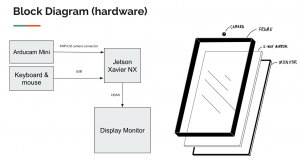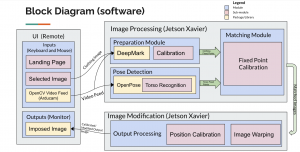This week we worked on compiling the design report. We divided up the sections of the report according to the division of the slides. Christina created the block diagrams for the design presentation, so she focused on the Architecture and System Description sections. Devon also focused on these sections in addition to the design trade-off sections. Judy worked on the schedule and project management sections of the presentations, so she focused on those sections in the design report. After dividing up the report, we met again to combine the different sections to ensure that the report had all of the aspects we wanted to include and flowed together well. Then, before submitting, we met one last time to polish and submit the report. In addition to this, we had a minor issue with ordering our parts, but after talking to Quinn about the orders, they were placed and we have already received the Jetson Xavier NX, arducam, and the monitor. We are still waiting on the mirror.
Devon’s Status Report for March 13
This week we began to implement our torso and clothes detection algorithms. I played around with OpenPose to get comfortable with it and see how it might work with the Xavier NX. This was a relatively slow week as we had our presentation but things will definitely pick up next week!
Judy’s Status Report for March 13, 2021
This week was design presentation week. We got feedback on our presentation and it was overall very positive. It seems that the scope and design of our projects seems achievable according to the feedback we got from our peers. In addition to this, I have begun researching how to create the user interface for the mirror. Since I am new to figma, it is taking me some time to learn how to design using figma. I am also researching into how we should do the UI and decide if we should do a web page or just a user interface platform using pkinter.
Team Status Report for March 13
This week we presented our design presentation slides. This went well and we got some useful feedback from students and professors. We each began getting more familiar with our aspects of the project – mainly the UI and software, for now until our materials come in and we are able to start implementing with hardware. We are testing and experimenting more with OpenPose and our UI.
Christina’s Status Report for March 13
This week I focused on preparing for the Design Review Presentation as I was the designated presenter this time around. I think it went pretty well. Reviewing the peer feedback, it seems most think we have a reasonable scope and design approach, which is reassuring. We got some very good feedback from the faculty on specific aspects of the project. Knowing that the Xavier will be treated as an item we’re borrowing opens up our budget a lot and gives flexibility for buying doubles if needed. As we wait for our parts to come in, I’ve started the setup for OpenCV and OpenPose. I’m following the installation guide on the github for MacOS. There are still some setup bugs, but I hope to begin playing around with torso recognition soon. I talked to the Work It team briefly after hearing their Design Review Presentation to get some insight on subtracting unnecessary functionality such as finger and lower body recognition since they also are using OpenPose. I’ll be using that advice as I continue to play around with OpenPose. I want to have a good understanding of it before the hardware comes in.
Devon’s Weekly Status Report for March 6
This week, I worked on the application area, solution approach and hardware block diagram slides for the design presentation. To further specify our design, I researched the current market space for smart mirrors similar to ours. I discovered that there are three main areas of smart mirrors: workout mirrors (like the MIRROR product), vanity smart mirrors (such as HiMirror, a product that gives you feedback for makeup and skincare), and DIY smart mirrors. There is also a subspace of commercial smart mirrors for clothing department stores but these are inaccessible to everyday users. This was valuable information since our product will take a unique approach in the smart mirror market by allowing the user to try on clothes. In addition to the market space, I also researched the construction and testing procedures for these products. I then looked into how the hardware components in our design will specifically function with each other. We decided that it is better to use the singular Arducam rather than the two depth-cams for our project. I also put in the orders for our parts so that we can begin assembling ASAP.
Christina’s Status Report for March 6
I’ll be the Design Review presenter. This week, I worked on the software block diagram, testing verification and metrics, and risk factor slides. I researched the various parts of our design to figure out how the software components will work together. I found that OpenCV will be needed to convert our live video feed from the Arducam to the Jetson. The live video feed and selected image of clothing will be run through a clothing detection module. We were originally planning on using DeepMark, but deprecation may lead us to use another option: https://github.com/lzhbrian/deepfashion2-kps-agg-finetune. After our meeting with the TA on Wednesday, we added scope discussion on the solution approach slide and indication of how the software and hardware components will work together in the block diagrams. Most of my time this week has been spent on research and preparing for the presentation.
Team Status Report for March 6
This week, we finalized our hardware list and filled out the forms for ordering our parts and are waiting on them to come in this week. We’ve starting thinking more about the details of how we will implement our design. Drawing the block diagrams allowed us to realize pieces of our design that we haven’t ironed out the details of such as the matching module. We’ll have to check the outputs of OpenPose and DeepMark and figure out how each set of fixed points correlate. At this point, this is still an unknown and is high priority to test out. Furthermore, the Jetson SDK’s interaction with the other software components are also unknown at this point, but we’ll have to hold on this until we get the Jetson. Our hardware and software block diagrams are shown below.


Judy’s Weekly Status Report for March 6th, 2021
The design presentation is due on Sunday so we worked mainly on creating and polishing the presentation. We divided up the slides so I focused on the User Interface, system specification, and implementation plan slides. I used figma for the first time to build a simple user interface. I used a pre-existing template and edited it to how the UI for the mirror should look. For system specification, I looked up all of the hardware we were considering purchasing and I looked at the price and specifications of each and totaled the price on the slide. For implementation plan, I looked at how we wanted the different components of the mirror to interact with each other. On Wednesday, during class time we met again to polish the slides we had each written and asked our TA to review and give us feedback. Then we submitted orders for each of our parts so hopefully we will get them by next week and we can start assembling.
Devon’s Status Report for February 28
I researched other similar products and investigated their user spaces as well as looked into how the products were implemented. I looked further into how we will use OpenCV, OpenPose and DeepMark together on the Jetson Xavier NX. I hope that next week we will be able to get our design completely finalized so we can begin developing.
